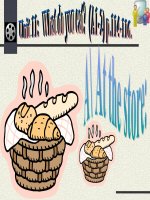Unit 10: What do you do at break time?
Bạn đang xem bản rút gọn của tài liệu. Xem và tải ngay bản đầy đủ của tài liệu tại đây (139.46 KB, 11 trang )
<span class='text_page_counter'>(1)</span><div class='page_container' data-page=1>
<b>Week:</b> <i>Date of teaching: </i>
<b>Period </b> <i>Date of planning: </i>
<b>UNIT 10: WHAT DO YOU DO AT BREAK TIME?</b>
<b>Lesson 1(Part 1, 2, 3</b>)
<b>Objectives</b> After the lesson, students are able to:
- Ask and answer questions about break-time activities.
<b>Language</b>
<b>focus</b>
<b>Vocabulary: break time, play, badminton, football, chess, basketball, table </b>
<i>tennis.</i>
<b>Sentence patterns: </b>
A: What do you do at break time?
B: I play………..
<b>Resources</b> Pictures, Puppets, Sts’ book, poster
<b>PROCEDURE</b>
<b>Steps and time</b> <b>Sts’ and T’s activities</b> <b>Language focus</b> <b>Modes</b>
<b>1. Warm-up:</b>
<b>3’</b>
- Have Ss chant “What colour is
<b>it?”</b>
Chant W-Class
Individual
<b>2.</b>
<b>Vocabulary:</b>
<b>2’</b>
-T follows the steps of presenting
new words.
-Sts follows T’s instructions.
<i>break time, play, </i>
<i>badminton, football, </i>
<i>chess, basketball, table </i>
<i>tennis.</i>
W-class
Individual
<b>3. Look, listen</b>
<b>and repeat</b>
<b>(10’)</b>
- Ask Ss to identify the characters
in the picture on page 64 and what
they are doing.
- Set the scene “you are going to
<i>listen to Linda and Mai asking </i>
<i>about some games.</i>
- Play the recording and asks Ss to
listen to the tape twice.
- Ask Ss to listen and repeat in
chorus two times.
- Have whole class repeat all the
phrases a few times to reinforce
their pronunciation.
<b>Sentence patterns: </b>
<i>A:What do you do at </i>
<i>break time?</i>
<i>B: I play badminton.</i>
W-class
Groups
Pairs
<b>4. Point and</b>
- Tell Ss that they are going to
practise asking and answering the
question:
<i><b>What do you do at break time?</b></i>
- Teach the vocabulary: chess,
<i>basketball, table tennis.</i>
</div>
<span class='text_page_counter'>(2)</span><div class='page_container' data-page=2>
<b>say: 10’</b>
individual.
- Point to the first picture and
elicit the word to fill the gap.
- Put the sentence on the board.
- Have Ss repeat a few times
- Get Ss to make the same
sentence, using the picture in the
book.
- Call some Ss to speak aloud.
- Correct their pronunciation if
needed.
a/ football
b/ basketball
c/ chess
d/ table tennis
W-class
Groups
Pairs
W-class
<b>5. Let’s talk :</b>
<b>8’</b>
- Tell Ss that they are going to
practise more with their friends.
- Give a few seconds for Ss to
look at the pictures and identify
each game
- Ask Ss to fill in the blank.
- Put the sentence on the board
and do chotal and individual
repetition.
- Get Ss to work in pairs, using
the picture in the book.
- Go around to offer help
- Correct the pronunciation, if
necessary.
- Call a few pairs to act out the
dialogue in front of the class.
<b>Sentence patterns: </b>
A: What do you do at
break time?
B: I play football/ table
tennis/ chess/ basketball…
Individual
Groups
Pairs
<b>6. Homelink :</b>
<b>2’</b>
-T tells the homelink, ss takenote. -Ask Ss to learn by heart
the games at home.
W-class
<b>*************************************</b>
<b>Week:</b> <i>Date of teaching: </i>
<b>Period </b> <i>Date of planning: </i>
<b>UNIT 10: WHAT DO YOU DO AT BREAK TIME?</b>
<b>Lesson 1(Part 4, 5, 6</b>)
<b>Objectives</b> After the lesson, students are able to:
- Ask and answer questions about break-time activities, improve listening and
reading skills.
<b>Language</b>
<b>focus</b>
<b>Vocabulary: break time, badminton, football, chess, basketball, table tennis.</b>
<b>Sentence patterns: </b>
</div>
<span class='text_page_counter'>(3)</span><div class='page_container' data-page=3>
B: I play………..
<b>Resources</b> Pictures, Puppets, Sts’ book, poster
<b>PROCEDURE</b>
<b>Steps and time</b> <b>Sts’ and T’s activities</b> <b>Language focus</b> <b>Modes</b>
<b>1. Warm-up:</b>
<b>3’</b>
- Call a few pairs the front of the
class to ask and answer the
question:
<i>A: What do you do at break time?</i>
<i>B: I play + game</i>
<b>Model:</b>
<i>A: What do you do at </i>
<i>break time?</i>
<i>B: I play football/ table </i>
<i>tennis/ chess/ </i>
<i>basketball…</i>
W-Class
Pairs
<b>2.</b>
<b>Vocabulary:</b>
<b>2’</b>
-T follows the steps of presenting
new words.
-Sts follows T’s instructions.
<i>break time, badminton, </i>
<i>football, chess, </i>
<i>basketball, table tennis</i>
W-class
Individual
<b>3. Listen and</b>
<b>tick: 10’</b>
- Tell Ss that they are going to
listen and tick the correct boxes
next the pictures.
- Give a few seconds for Ss to
look at the pictures.
- Play the recording 3 times
through for Ss to listen and tick
the correct answers.
- Ask Ss to exchange their
answers with their partners before
reporting them to the class.
- Call some Ss to read loud their
answers.
- Listen and give feedback.
*Answers:1.b; 2.b; 3.a
W-class
Individual
Pairs
<b>4. Read and</b>
<b>write: 10’</b>
- Tell Ss what they are going to
fill the gap.
- Ask Ss to look at the pictures
and read the text.
- Elicit the words filling the gaps.
- Ask Ss to read individually
silently and complete the
sentences.
- Go around to offer help if
necessary.
- Get Ss to swap and check their
answers with their friends.
- Ask Ss to read their answers
<b>Key:</b>
1. chess
2. table tennis
3. badminton
W-class
Individual
</div>
<span class='text_page_counter'>(4)</span><div class='page_container' data-page=4>
aloud to the class.
<b>5. Write about</b>
<b>you :8’</b>
<i>- Tell Ss that they are going to </i>
write about their activities at
break time.
- Check comprehension and give
feedback.
- Give Ss 2 mins to do the task.
- Get Ss to swap and check their
answers before writing the correct
answers on the board for Ss to
copy down into their notebooks.
- Call some Ss to write their
sentences on the board.
- Read and correct if needed.
<b>Key:</b>
<i>I play + <b>(Ss’own games.)</b></i> <sub>Individual</sub>W-class
<b>6. Homelink :</b>
<b>2’</b>
-T tells the homelink, ss takenote. - Have Ss learn by heart
the vocabulary about
games at home.
W-class
<b>*************************************</b>
<b>Week:</b> <i>Date of teaching: </i>
<b>Period </b> <i>Date of planning: </i>
<b>UNIT 10: WHAT DO YOU DO AT BREAK TIME?</b>
Lesson 2(Part 1, 2, 3)
<b>Objectives</b> After the lesson, students are able to:
- Ask and answer about games they like playing at break time , develop
speaking skill.
- Develop speaking and listening skills.
<b>Language</b>
<b>focus</b>
<b>Vocabulary: like, hide – and – seek, skipping, skating, blind man’s bluff</b>
<b>Sentence patterns: </b>
<i>a,A: Do you like badminton ?</i>
<i>B: Yes, I do</i>
<i>b,A: Do you like hide- and- seek? </i>
<i>B: No, I don’t.</i>
<b>Resources</b> Pictures, Puppets, Sts’ book, poster
<b>PROCEDURE</b>
<b>Steps and time</b> <b>Sts’ and T’s activities</b> <b>Language focus</b> <b>Modes</b>
<b>1. Warm-up:</b>
<b>3’</b>
- Call some Ss go to the board and
recall some new words.
W-Class
Group
<b>2.</b>
<b>Vocabulary:</b>
-T follows the steps of presenting
new words.
<i>like, hide – and – seek, </i>
</div>
<span class='text_page_counter'>(5)</span><div class='page_container' data-page=5>
<b>2’</b> -Sts follows T’s instructions. <i>man’s bluff</i> Individual
<b>3. Look, listen</b>
<b>and repeat:</b>
<b>10’</b>
- Have Ss look at the pictures a, b,
c, d on page 66.
- Elicit the actives in the pictures
and their doing.
- Tell them to guess and respond
to the first character. Then fill the
speech bubbles with the correct
phrases prompted by Ss.
- Have ss repeat a few times.
- T models the dialogue
<i><b>A</b>: Do you like playing badminton</i>
<i>?</i>
<i><b>B</b>: Yes, I do / No, I don’t. I like </i>
<i>playing chess</i>
- Have the whole class repeat all
the phrases.
- Ask Ss to practice in pairs
- Monitor the activity, check the
pronunciation ( sound,
assimilation of sound and
intonation) and offer help when
necessary.
- Call on some pairs to perform
the task at the front of the class.
Others observe and comment.
- Have the whole class repeat the
question and answer in chorus to
reinforce their pronunciation.
<b>Model sentence:</b>
<i><b>A</b>: Do you like playing </i>
<i>badminton ?</i>
<i><b>B</b>: Yes, I do / No, I don’t. </i>
<i>I like playing chess</i> W-class
Groups
Pairs
<b>4. Point and</b>
<b>say: 10’</b>
- Tell Ss that they are going to
practice asking and answering
questions <i><b>Do you like + </b></i>
<i><b>(activity)?</b></i>
- Draw Ss’ attention to the
pictures.
- Check comprehension and teach
the new vocabulary:
<i>like, hide – and – seek, skipping, </i>
<i>skating, blind man’s bluff </i>
- Read loud the vocabulary a few
times, have Ss repeat chorally and
<i><b>Key:</b></i>
<i>1. skipping/yes</i>
<i>2. skating/yes</i>
<i>3. hide-and-seek/no</i>
<i>4. blind man’s bluff/no</i>
W-class
Groups
</div>
<span class='text_page_counter'>(6)</span><div class='page_container' data-page=6>
individually
- Have Ss repeat the text in
bubbles a few times.
- Point to the pictures and elicit
the words to fill the gaps.
- Put the sentences on the board.
- Have class repeat the question
and the answer.
- Have Ss repeat a few times
chorally and individually.
- Ask Ss to practise in pairs
- Call some Ss to practise in front
of the class.
<b>5. Let’s talk :</b>
<b>8’</b>
- Tell Ss that they are going
practise more with their friends
- Give Ss 3 seconds to look at the
pictures, elicit the name of each
activity.
- Ask Ss to predict the
information they have to fill in the
gaps.
- Call some Ss to read loud their
prediction.
- Have some Ss make their
sentences based on these pictures
- Put them on the board and have
Ss repeat them a few times.
- Do the first picture as example if
Ss don’t understand.
- Ask Ss work in pairs in 5 mins
- Call some pairs to act out the
dialogue
- Give comments.
<b>Sentence patterns:</b>
<i>A:Do you like + (activity)</i>
<i>?</i>
<i>B: Yes, I do/ No, I don’t</i>
W-Class
Individual
W-class
<b>6. Homelink :</b>
<b>2’</b>
-T tells the homelink, ss takenote. - Ask Ss to practise asking
and answering about the
activities at home.
W-class
<b>*************************************</b>
<b>Week:</b> <i>Date of teaching: </i>
<b>Period </b> <i>Date of planning: </i>
<b>UNIT 10: WHAT DO YOU DO AT BREAK TIME?</b>
</div>
<span class='text_page_counter'>(7)</span><div class='page_container' data-page=7>
<b>Objectives</b> After the lesson, students are able to:
- Talk about activities they like playing at break time , develop listening and
reading skill.
<b>Language</b>
<b>focus</b>
<b>Vocabulary: like, hide – and – seek, skipping, skating, blind man’s bluff</b>
<b>Resources</b> Pictures, Puppets, Sts’ book, poster
<b>PROCEDURE</b>
<b>Steps and time</b> <b>Sts’ and T’s activities</b> <b>Language focus</b> <b>Modes</b>
<b>1. Warm-up:</b>
<b>3’</b>
- Tell Ss that they are going to ask
and answer the structure:
<i>A: Do you like + (activity)</i>
<i>B: Yes, I do / No, I don’t</i>
<b>Model:</b>
<i>A: Do you like chess?</i>
<i>B: Yes, I do/ No, I don’t </i> W-Class<sub>Pairs</sub>
<b>2.</b>
<b>Vocabulary:</b>
<b>2’</b>
-T recalls all the new words.
-Sts follows T’s instructions.
<i>like, hide – and – seek, </i>
<i>skipping, skating, blind </i>
<i>man’s bluff</i>
W-class
Individual
<b>3. Listen and</b>
<b>number: 10’</b>
- Ask Ss to pay attention to 4
pictures on page 67 then identify
the activities
- Ask Ss to predict the order of
these picture.
- Write their prediction on the
board.
- Ask Ss to listen to the tape and
choose , number the right picture
then write the number in the
picture Ss hear.
- Play the tape three times to
listen
- Call some Ss to read loud their
answer with their explanations.
- Play the tape again to check
their predicts with their answers
- Give feedback and comments.
Key:
1. c
2. b
3. d
4. a
W-class
Individual
W-class
<b>4. Read and</b>
<b>write: 10’</b>
- Read loud the text and the
sentences in exercise 5.
- Ask Ss to work in pairs in 5
mins to read and fill the correct
word phrases for the exercise
- Go around to help Ss
- Get Ss to write their answers on
Key:
<i><b>1. table tennis</b></i>
<i><b>2. like chess</b></i>
<i><b>3. They like badminton</b></i>
</div>
<span class='text_page_counter'>(8)</span><div class='page_container' data-page=8>
the board.
- Check and correct mistakes
- Ask Ss to read aloud all
sentences.
<b>5. Let’s sing :</b>
<b>8’</b>
<i>- Ask Ss to open their Student’s </i>
book on page 67. Tell them that
they are going to sing the <i><b>Hide – </b></i>
<i><b>and – seek </b></i>song.
- Play the recording 3 times for Ss
to get familiarized with the
pronunciation, the stress, the
rhythm and the intonation of the
song.
- Play the recording again,
pausing after each line for Ss to
repeat.
- Play the recording once more for
Ss to repeat the whole song.
- Call on some Ss to sing the
song in front of the class. The
rest of the class clap their hands at
rhythms.
Sing the song.
W-class
Individual
<b>6. Homelink :</b>
<b>2’</b>
-T tells the homelink, ss takenote. Have Ss to sing the song
<i><b>Hide – and – seek </b></i> at
home.
W-class
<b>*************************************</b>
<b>Week:</b> <i>Date of teaching: </i>
<b>Period </b> <i>Date of planning: </i>
<b>UNIT 10: WHAT DO YOU DO AT BREAK TIME?</b>
<b>Lesson 3(Part 1, 2, 3</b>)
<b>Objectives</b> After the lesson, students are able to:
- Listen and repeat words, listen and write.
- Do the chant “What do you do at break time?”
- Develop Ss writing and listening skills.
<b>Language</b>
<b>focus</b>
<b>Vocabulary: break time</b>
<b>Phonic: bl, sk</b>
<b>Resources</b> Pictures, Puppets, Sts’ book, poster
<b>PROCEDURE</b>
</div>
<span class='text_page_counter'>(9)</span><div class='page_container' data-page=9>
<b>1. Warm-up:</b>
<b>3’</b>
- Sing the My new pen song.
Sing the song
W-Class
Group
<b>2. Phonics:</b>
<b>2’</b>
-T introduce the phonics: bl, sk.
-Sts follows T’s instructions.
<i>bl, sk</i> W-class
Individual
<b>3. Listen and</b>
<b>repeat: 10’</b>
-T shows the words, models the
phonics “bl,sk”, asks ss to repeat
phonics.
-Ss try to read “bl,sk” and “blind,
skate”.
<b>bl blind Do you like</b>
blind man’s bluff?
<b>sk skate I like skating.</b>
W-class
Individual
<b>4. Listen and</b>
<b>write: 10’</b>
- Ask Ss to pay attention to
exercise 2 on page 68.
- Ask Ss to read 2 sentences and
guess the missing information.
- Play the tape 3 times and ask Ss
to listen carefully.
- Ask Ss to write the words they
hear then exchange the
information with their partner.
- Call some Ss to write their
answers on the board.
- Play the tape again and check
with whole class
- Check and give feedback.
<b>Modes:</b>
1. I don’t like chess. I like
blind man’s bluff.
2. They like skating.
W-class
Individual
W-class
<b>5. Let’s</b>
<b>chant :8’</b>
- Play the tape <i><b>“ What do you do </b></i>
<i><b>at break time?” </b></i>for Ss to listen
while they are reading the chant
in their books.
- Call on a group of six: three of
them to repeat each line of the
chant.
- Show Ss how to say the chant
and do the actions.
- Play the recording a few times
for Ss to do choral and individual
repetition.
- Have Ss practice the chant in
groups and clap the syllables.
- Monitor the activity and offer
help when necessary/ correct
typical pronunciation errors.
<b>What do you do at break</b>
<b>time?</b>
W-class
Individual
</div>
<span class='text_page_counter'>(10)</span><div class='page_container' data-page=10>
- Call on a group to recite the
chant. The others clap the
syllables
- Listen and give comments.
<b>6. Homelink :</b>
<b>2’</b>
-T tells the homelink, ss takenote. Have Ss to practise
chanting <i><b>“What do you </b></i>
<i><b>do at break time?”</b></i>at
home.
W-class
<b>*************************************</b>
<b>Week:</b> <i>Date of teaching: </i>
<b>Period </b> <i>Date of planning: </i>
<b>UNIT 10: WHAT DO YOU DO AT BREAK TIME?</b>
<b>Lesson 3(Part 4, 5, 6</b>)
<b>Objectives</b> After the lesson, students are able to:
- Read and do matching.
- Develop Ss writing skills.
<b>Language</b>
<b>focus</b>
Pattern: “Review”.; Vocab: Review
<b>Resources</b> Pictures, Puppets, Sts’ book, poster
<b>PROCEDURE</b>
<b>Steps and time</b> <b>Sts’ and T’s activities</b> <b>Language focus</b> <b>Modes</b>
<b>1. Warm-up:</b>
<b>3’</b>
- Have Ss chant “What do you do
<b>at break time?”</b>
Chant W-Class
Group
<b>2.</b>
<b>Vocabulary:</b>
<b>2’</b>
-T recalls all the new words.
-Sts follows T’s instructions.
<i>Review</i> W-class
Individual
<b>3. Read and</b>
<b>match: 10’</b>
- Tell Ss that they are going to
read the sentences on the left and
pair them with those on the right
by drawing a line between them.
- Give a few second for Ss to read
the text in silence. Check
comprehension and give
feedback.
- Give 4 mins for Ss to do the task
in pairs.
- Go around to offer help if
necessary.
- Get Ss to swap and check their
<i>Answers: </i>
<i>1 – b; 2 – c; 3 – a; 4 – d; </i>
W-class
Individual
</div>
<span class='text_page_counter'>(11)</span><div class='page_container' data-page=11>
answers before checking as a
class.
- Call a few open pairs to read the
dialogues.
<b>4. Write about</b>
<b>you: 10’</b>
- Tell Ss that they are going to
write about themselves. Give a
few seconds for them to look at
the pictures.
- Ask Ss do the task.
- Check their answers.
- Call a few Ss to read their
answesrs aloud.
Key:
Ss’s own answers.
W-class
Individual
W-class
<b>5. Project :8’</b>
- Tell Ss that they are going to
play Bingo game.
- Explain how the game is played.
- Ask Ss to make sentences with
the words crossed.
- Give comment.
Play the game. <sub>W-class</sub>
<b>6. Homelink :</b>
<b>2’</b>
-T tells the homelink, ss take note. - Have Ss play game at
home.
</div>
<!--links-->









